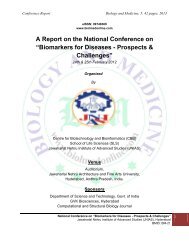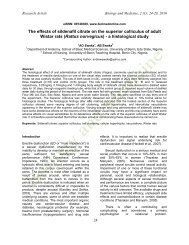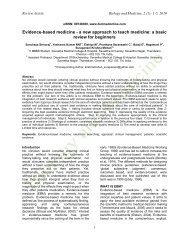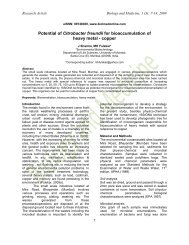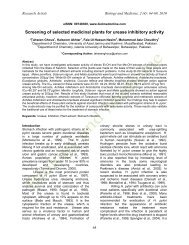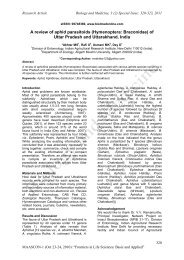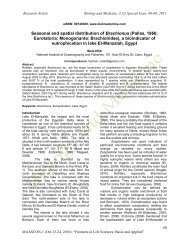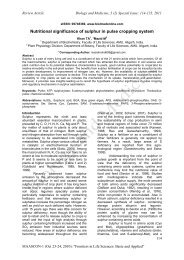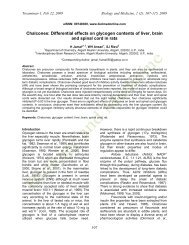Immunomodulatory effects of Tinospora cordifolia (Guduchi) on ...
Immunomodulatory effects of Tinospora cordifolia (Guduchi) on ...
Immunomodulatory effects of Tinospora cordifolia (Guduchi) on ...
Create successful ePaper yourself
Turn your PDF publications into a flip-book with our unique Google optimized e-Paper software.
Research Article Biology and Medicine, 3 (2) Special Issue: 134-140, 2011<br />
eISSN: 09748369, www.biolmed<strong>on</strong>line.com<br />
<str<strong>on</strong>g>Immunomodulatory</str<strong>on</strong>g> <str<strong>on</strong>g>effects</str<strong>on</strong>g> <str<strong>on</strong>g>of</str<strong>on</strong>g> <str<strong>on</strong>g>Tinospora</str<strong>on</strong>g> <str<strong>on</strong>g>cordifolia</str<strong>on</strong>g> (<str<strong>on</strong>g>Guduchi</str<strong>on</strong>g>) <strong>on</strong><br />
macrophage activati<strong>on</strong><br />
More P, *Pai K<br />
Department <str<strong>on</strong>g>of</str<strong>on</strong>g> Zoology, Centre for Advanced Studies, University <str<strong>on</strong>g>of</str<strong>on</strong>g> Pune, Ganesh Khind,<br />
Pune 411007, Maharashtra (India).<br />
*Corresp<strong>on</strong>ding Author: kalpnapai@yahoo.co.in, morepm207@gmail.com<br />
Abstract<br />
Macrophages are the first line <str<strong>on</strong>g>of</str<strong>on</strong>g> defense and c<strong>on</strong>stitute important participants in the bi-directi<strong>on</strong>al interacti<strong>on</strong><br />
between innate and specific immunity. Macrophages are in a quiescent form and are activated when given a<br />
stimulus. In the present study, we have used <str<strong>on</strong>g>Tinospora</str<strong>on</strong>g> <str<strong>on</strong>g>cordifolia</str<strong>on</strong>g>, comm<strong>on</strong>ly known as <str<strong>on</strong>g>Guduchi</str<strong>on</strong>g>, to see its effect<br />
<strong>on</strong> macrophage activati<strong>on</strong>. The direct drug treatment to J774A cells showed activati<strong>on</strong> as assessed by<br />
biochemical assays. Enhanced secreti<strong>on</strong> <str<strong>on</strong>g>of</str<strong>on</strong>g> lysozyme by macrophage cell line J774A <strong>on</strong> treatment with<br />
<str<strong>on</strong>g>Tinospora</str<strong>on</strong>g> <str<strong>on</strong>g>cordifolia</str<strong>on</strong>g> and lipopolysacharide was observed, suggesting activated state <str<strong>on</strong>g>of</str<strong>on</strong>g> macrophages. Enhanced<br />
lysozyme producti<strong>on</strong> was reported at different time intervals (24 hrs and 48 hrs). This led us to check the effect <str<strong>on</strong>g>of</str<strong>on</strong>g><br />
the drug <strong>on</strong> the functi<strong>on</strong>al activity <str<strong>on</strong>g>of</str<strong>on</strong>g> macrophage with respect to microbicidal properties by disk diffusi<strong>on</strong><br />
antibiotic sensitivity test. The enhanced inhibitory <str<strong>on</strong>g>effects</str<strong>on</strong>g> <str<strong>on</strong>g>of</str<strong>on</strong>g> T. <str<strong>on</strong>g>cordifolia</str<strong>on</strong>g> (direct effect) and T. <str<strong>on</strong>g>cordifolia</str<strong>on</strong>g> treated<br />
cell supernatant (indirect effect) <strong>on</strong> the bacteria (E. coli) indicates the susceptibility <str<strong>on</strong>g>of</str<strong>on</strong>g> bacteria. This study is an<br />
attempt to check the potential significance <str<strong>on</strong>g>of</str<strong>on</strong>g> the T. <str<strong>on</strong>g>cordifolia</str<strong>on</strong>g> to be used as immunomodulator for activati<strong>on</strong> <str<strong>on</strong>g>of</str<strong>on</strong>g><br />
macrophages.<br />
Keywords: BRM; LPS; <str<strong>on</strong>g>Guduchi</str<strong>on</strong>g>; macrophage activati<strong>on</strong>; lysozyme; nitric oxide.<br />
Introducti<strong>on</strong><br />
Macrophages are quiescent cells which get<br />
activated when stimulated. Different types <str<strong>on</strong>g>of</str<strong>on</strong>g><br />
agents such as antibiotics, antimetabolites and<br />
cytokines may exert an immunomodulating<br />
acti<strong>on</strong> that is expressed in the augmentati<strong>on</strong><br />
and/or inhibiti<strong>on</strong> <str<strong>on</strong>g>of</str<strong>on</strong>g> different immune<br />
resp<strong>on</strong>ses (Pai et al., 1997). One <str<strong>on</strong>g>of</str<strong>on</strong>g> the most<br />
promising recent alternatives to classical<br />
antibiotic treatment is the use <str<strong>on</strong>g>of</str<strong>on</strong>g><br />
immunomodulators for enhancing host<br />
defense resp<strong>on</strong>ses (Tzianabos, 2000). Disc<br />
diffusi<strong>on</strong> method is used to test the survival <str<strong>on</strong>g>of</str<strong>on</strong>g><br />
bacteria to any antimicrobicidal activity. The<br />
results <str<strong>on</strong>g>of</str<strong>on</strong>g> disc diffusi<strong>on</strong> tests depend up<strong>on</strong> a<br />
number <str<strong>on</strong>g>of</str<strong>on</strong>g> variables, <str<strong>on</strong>g>of</str<strong>on</strong>g> which media, antibiotic<br />
c<strong>on</strong>centrati<strong>on</strong> <strong>on</strong> the disc and inoculum size<br />
are the most important. Many efforts have<br />
been made to standardise methodology within<br />
countries, such as various modified versi<strong>on</strong>s <str<strong>on</strong>g>of</str<strong>on</strong>g><br />
the Kirby-Bauer method in the USA (NCCSL,<br />
1984), and between countries, such as the<br />
WHO guidelines <strong>on</strong> susceptibility testing<br />
suggested in 1961 (WHO, 1961).<br />
A number <str<strong>on</strong>g>of</str<strong>on</strong>g> natural products and<br />
synthetic immunopotentiators termed as<br />
Biological Resp<strong>on</strong>se Modifiers (BRMs) are<br />
becoming increasingly popular for testing their<br />
potential for augmenting immune resp<strong>on</strong>ses.<br />
Am<strong>on</strong>g the natural BRMs many herbs and<br />
medicinal plants have l<strong>on</strong>g been known for<br />
their immunoaugmentary potential, however,<br />
<strong>on</strong>ly recently scientists have recognized them<br />
for their possible BRM acti<strong>on</strong>s. The herb<br />
isolated from botanical sources – T. <str<strong>on</strong>g>cordifolia</str<strong>on</strong>g><br />
or <str<strong>on</strong>g>Guduchi</str<strong>on</strong>g> has attracted a great deal <str<strong>on</strong>g>of</str<strong>on</strong>g><br />
attenti<strong>on</strong> in the biomedical arena because <str<strong>on</strong>g>of</str<strong>on</strong>g><br />
its broad spectrum <str<strong>on</strong>g>of</str<strong>on</strong>g> therapeutic properties<br />
and relatively low toxicity. While our<br />
understanding <str<strong>on</strong>g>of</str<strong>on</strong>g> the mechanism <str<strong>on</strong>g>of</str<strong>on</strong>g> acti<strong>on</strong> <str<strong>on</strong>g>of</str<strong>on</strong>g><br />
these BRM is still developing, it appears that<br />
the primary mechanisms involve inducti<strong>on</strong> <str<strong>on</strong>g>of</str<strong>on</strong>g><br />
the immune system. The basic mechanism <str<strong>on</strong>g>of</str<strong>on</strong>g><br />
the immunostimulatory, antitumor, bactericidal<br />
and other therapeutic <str<strong>on</strong>g>effects</str<strong>on</strong>g> <str<strong>on</strong>g>of</str<strong>on</strong>g> BRMs is<br />
thought to occur via macrophage activati<strong>on</strong>.<br />
We have focused this study <strong>on</strong> the role <str<strong>on</strong>g>of</str<strong>on</strong>g> the<br />
BRM (<str<strong>on</strong>g>Guduchi</str<strong>on</strong>g>) <strong>on</strong> macrophage functi<strong>on</strong>s.<br />
Macrophage activati<strong>on</strong> with the BRM<br />
treatment can be measured by different<br />
markers. Analysis <str<strong>on</strong>g>of</str<strong>on</strong>g> the development <str<strong>on</strong>g>of</str<strong>on</strong>g><br />
activati<strong>on</strong> is facilitated when the operati<strong>on</strong>ally<br />
defined stages <str<strong>on</strong>g>of</str<strong>on</strong>g> activati<strong>on</strong> is characterized<br />
using a library <str<strong>on</strong>g>of</str<strong>on</strong>g> markers for activati<strong>on</strong>. In the<br />
present study, we have assessed the direct<br />
and indirect <str<strong>on</strong>g>effects</str<strong>on</strong>g> <str<strong>on</strong>g>of</str<strong>on</strong>g> <str<strong>on</strong>g>Guduchi</str<strong>on</strong>g> <strong>on</strong> macrophage<br />
activati<strong>on</strong>.<br />
Materials and Methods<br />
Reagents: RPMI 1640 with L-glutamine and 25<br />
mM HEPES buffer were purchased from<br />
HiMedia Pvt. Ltd. India. Fetal bovine serum<br />
was purchased from Hycl<strong>on</strong>e (Logan, USA)<br />
and heat inactivated at 56 0 C for 30 min. The<br />
drug (<str<strong>on</strong>g>Guduchi</str<strong>on</strong>g>) used was obtained from<br />
MAASCON-1 (Oct 23-24, 2010): “Fr<strong>on</strong>tiers in Life Sciences: Basic and Applied”<br />
134
Research Article Biology and Medicine, 3 (2) Special Issue: 134-140, 2011<br />
Himalaya Drug Company, India. All other<br />
chemicals and solvents used in this study<br />
were obtained from Sigma Chemical Company<br />
(St. Louis, USA) and were <str<strong>on</strong>g>of</str<strong>on</strong>g> analytical grade<br />
or the highest grade available.<br />
Cells: The macrophage J774A.1 cell line,<br />
purchased from Nati<strong>on</strong>al Center for Cell<br />
Sciences (NCCS, Pune), was used as source<br />
<str<strong>on</strong>g>of</str<strong>on</strong>g> macrophages (Origin: BALB/c mouse;<br />
Nature: Mature), grown and maintained in the<br />
RPMI 1640 medium (pH 7.2-7.4) enriched with<br />
10% Fetal Bovine Serum, at 37 0 C and 5% CO2<br />
envir<strong>on</strong>ment.<br />
Viability assay: Cell viability was determined<br />
by the Trypan blue dye exclusi<strong>on</strong> technique.<br />
Equal volumes <str<strong>on</strong>g>of</str<strong>on</strong>g> cell suspensi<strong>on</strong>s were mixed<br />
with 0.4% Trypan blue in PBS, and the<br />
unstained viable cells were determined. These<br />
cells were further used for cytotoxicity assay in<br />
2 x 10 6 density per ml in the 96 well tissue<br />
culture plate.<br />
Stimulati<strong>on</strong> <str<strong>on</strong>g>of</str<strong>on</strong>g> macrophages: The macrophage<br />
cells (cell line J774A) from late log phase <str<strong>on</strong>g>of</str<strong>on</strong>g><br />
growth (subc<strong>on</strong>fluent) were seeded in 96 well<br />
flat bottom microtitter plates (Tars<strong>on</strong>s, India) in<br />
a volume <str<strong>on</strong>g>of</str<strong>on</strong>g> 100µl under adequate culture<br />
c<strong>on</strong>diti<strong>on</strong>s. Drugs were added in different<br />
c<strong>on</strong>centrati<strong>on</strong>s in a volume <str<strong>on</strong>g>of</str<strong>on</strong>g> 100µl in<br />
triplicate. The cultures were incubated at 37 0 C<br />
and 5% CO2 envir<strong>on</strong>ment. After 24 hr and 48<br />
hr incubati<strong>on</strong> percent viability was checked<br />
and culture supernatants were collected and<br />
assayed for nitric oxide and lysozyme activity.<br />
Cytotoxicity assay: In order to detect the<br />
toxicity <str<strong>on</strong>g>of</str<strong>on</strong>g> herbal preparati<strong>on</strong> the cytotoxicity<br />
assay was standardized by using 3-(4,5<br />
dimethylthiazol-2-yl)-2,5-diphenyltetrazolium<br />
bromide (MTT) at different time intervals for<br />
24 hrs and 48 hrs (Mosmann, 1983) using the<br />
drug at various c<strong>on</strong>centrati<strong>on</strong>s. After 24 hrs<br />
and 48 hrs <str<strong>on</strong>g>of</str<strong>on</strong>g> incubati<strong>on</strong>, supernatants were<br />
collected and ten microlitres <str<strong>on</strong>g>of</str<strong>on</strong>g> MTT (3 mg/ml)<br />
was added to each well and plates were<br />
further incubated for 2 hrs. The enzyme<br />
reacti<strong>on</strong> was then stopped by additi<strong>on</strong> <str<strong>on</strong>g>of</str<strong>on</strong>g> 150ul<br />
<str<strong>on</strong>g>of</str<strong>on</strong>g> dimethyl sulphoxide (DMSO). Plates were<br />
incubated for 10 min under agitati<strong>on</strong> at room<br />
temperature before the optical density at<br />
570nm was read under an ELISA plate reader.<br />
Three independent experiments in triplicate<br />
were performed for the determinati<strong>on</strong> <str<strong>on</strong>g>of</str<strong>on</strong>g><br />
sensitivity to each drug. Cells treated with<br />
medium al<strong>on</strong>e were c<strong>on</strong>sidered as C<strong>on</strong>trol.<br />
Percent viability was calculated by the given<br />
formula.<br />
Percent viability = E x 100<br />
C<br />
where E is the absorbance <str<strong>on</strong>g>of</str<strong>on</strong>g> treated cells and<br />
C is the absorbance <str<strong>on</strong>g>of</str<strong>on</strong>g> untreated cells.<br />
Nitrite assay: The c<strong>on</strong>centrati<strong>on</strong> <str<strong>on</strong>g>of</str<strong>on</strong>g> stable<br />
nitrite, an end product <str<strong>on</strong>g>of</str<strong>on</strong>g> the nitric oxide<br />
present in the supernatant <str<strong>on</strong>g>of</str<strong>on</strong>g> treated or<br />
untreated J774A macrophage cell cultures (2 x<br />
10 6 cells/ml), was measured by the method <str<strong>on</strong>g>of</str<strong>on</strong>g><br />
(Ding et al.,1988) based <strong>on</strong> the Griess<br />
reacti<strong>on</strong>. Briefly, 50 ul <str<strong>on</strong>g>of</str<strong>on</strong>g> supernatant was<br />
incubated with an equal volume <str<strong>on</strong>g>of</str<strong>on</strong>g> Griess<br />
reagent (1% sulphanilamide in 2.5 % H3PO4<br />
and 0.1% naphthyl-ethylene-diaminedihydrochloride<br />
in distilled water; both<br />
soluti<strong>on</strong>s mixed in a ratio <str<strong>on</strong>g>of</str<strong>on</strong>g> 1:1 at room<br />
temperature) for 10 min. The absorbance at<br />
550 nm was then measured in a microtitre<br />
plate reader. The standard curve for nitrite was<br />
prepared by using 10-100 µM sodium nitrite in<br />
distilled water.<br />
Assay for lysozyme: Lysozyme assay was<br />
performed with culture supernatants from<br />
treated and untreated macrophage cultures by<br />
the method described by Litwack (1955). A<br />
substrate suspensi<strong>on</strong> <str<strong>on</strong>g>of</str<strong>on</strong>g> dried and killed<br />
Micrococcus luteus (0.1 mg/ml) was prepared<br />
in 0.1 M sodium phosphate buffer at pH 6.2<br />
and 0.1 ml culture supernatant collected from<br />
treated and untreated macrophages were<br />
added to each tubes c<strong>on</strong>taining 2.5 ml <str<strong>on</strong>g>of</str<strong>on</strong>g><br />
substrate buffer kept at 37 0 C. Optical density<br />
at 600 nm was checked at zero hour <str<strong>on</strong>g>of</str<strong>on</strong>g><br />
incubati<strong>on</strong>. The tubes were then incubated at<br />
37 0 C for 1 hr and decrease in optical density<br />
was checked at 600 nm. Experiments were<br />
repeated three times in triplicates and enzyme<br />
activity expressed in units/ml culture<br />
supernatant / 2 x 10 6 cells / ml.<br />
Kirby-Bauer antibiotic testing or disk diffusi<strong>on</strong><br />
antibiotic sensitivity testing:<br />
The antibacterial susceptibility has been<br />
checked by using the Kirby-Bauer method<br />
(Williams, 1990; NCCSL, 1984; WHO, 1961).<br />
This method is used for testing the<br />
antimicrobial susceptibility <str<strong>on</strong>g>of</str<strong>on</strong>g> bacteria based<br />
<strong>on</strong> the size <str<strong>on</strong>g>of</str<strong>on</strong>g> z<strong>on</strong>es <str<strong>on</strong>g>of</str<strong>on</strong>g> inhibiti<strong>on</strong> <str<strong>on</strong>g>of</str<strong>on</strong>g> growth <str<strong>on</strong>g>of</str<strong>on</strong>g> a<br />
lawn culture around disks impregnated with<br />
the antimicrobial drug. A cell suspensi<strong>on</strong> <str<strong>on</strong>g>of</str<strong>on</strong>g><br />
freshly grown E. coli by comparing with the 0.5<br />
McFarland turbidity standard was prepared. A<br />
suspensi<strong>on</strong> in the range <str<strong>on</strong>g>of</str<strong>on</strong>g> 10 7 -10 8 cells was<br />
prepared by adjusting, according to the 0.5<br />
McFarland standard which was diluted by<br />
adding sterile water to obtain a suspensi<strong>on</strong> <str<strong>on</strong>g>of</str<strong>on</strong>g><br />
upto 10 6 cells <str<strong>on</strong>g>of</str<strong>on</strong>g> E. coli (McFarland, 1907;<br />
MAASCON-1 (Oct 23-24, 2010): “Fr<strong>on</strong>tiers in Life Sciences: Basic and Applied”<br />
135
Research Article Biology and Medicine, 3 (2) Special Issue: 134-140, 2011<br />
Finegold, 1986; Lennette, 1985). 100 µl <str<strong>on</strong>g>of</str<strong>on</strong>g> this<br />
suspensi<strong>on</strong> was spread <strong>on</strong> a sterile Luria-agar<br />
plate using a sterile glass spreader which was<br />
surface sterilized in absolute alcohol after<br />
every use. Two sterile paper discs made <str<strong>on</strong>g>of</str<strong>on</strong>g><br />
Whatman paper no. 1 were placed in <strong>on</strong>e plate<br />
to check the direct drug effect. 5 µl <str<strong>on</strong>g>of</str<strong>on</strong>g> the drug<br />
(<str<strong>on</strong>g>Guduchi</str<strong>on</strong>g>, 80µg/ml) and incomplete medium<br />
(RPMI 1640 as c<strong>on</strong>trol) were then added <strong>on</strong><br />
each disc. The indirect effect was checked<br />
with the drug treated or untreated cell<br />
supernatants at different time intervals (24h<br />
and 48h) in another plates. All the above steps<br />
were performed in sterile c<strong>on</strong>diti<strong>on</strong>s. The<br />
plates were incubated at 37 0 C in a BOD<br />
incubator for 18-24 hours. After incubati<strong>on</strong>, the<br />
diameter <str<strong>on</strong>g>of</str<strong>on</strong>g> the z<strong>on</strong>e <str<strong>on</strong>g>of</str<strong>on</strong>g> growth inhibiti<strong>on</strong> was<br />
measured and scored according to the size <str<strong>on</strong>g>of</str<strong>on</strong>g><br />
the z<strong>on</strong>e as sensitive intermediate or resistant.<br />
LPS treatment was c<strong>on</strong>sidered as positive<br />
c<strong>on</strong>trol.<br />
Treatment<br />
Statistical analysis: Statistical significance <str<strong>on</strong>g>of</str<strong>on</strong>g><br />
difference between the c<strong>on</strong>trol and<br />
experimental samples was calculated by<br />
Student’s t- test. All the experiments were<br />
d<strong>on</strong>e in triplicate samples. C<strong>on</strong>clusi<strong>on</strong>s were<br />
drawn from 3 independent experiments.<br />
Results<br />
Table 1: Effect <str<strong>on</strong>g>of</str<strong>on</strong>g> BRMs <strong>on</strong> the viability <str<strong>on</strong>g>of</str<strong>on</strong>g> J774A cells.<br />
C<strong>on</strong>centrati<strong>on</strong><br />
Viability and proliferati<strong>on</strong> <str<strong>on</strong>g>of</str<strong>on</strong>g> J774A cells:<br />
J774A cells showed 100% viability before the<br />
drug treatment by trypan blue dye exclusi<strong>on</strong><br />
test. The cells were treated with drugs initially<br />
<strong>on</strong> log scale and then <strong>on</strong> linear scale. J774A<br />
cells were incubated in medium al<strong>on</strong>e or drug<br />
for 24 h and 48 h and checked for percent<br />
viability as described in Materials and<br />
Methods. <str<strong>on</strong>g>Guduchi</str<strong>on</strong>g> in c<strong>on</strong>centrati<strong>on</strong> 80µg/ml<br />
showed maximum viability <str<strong>on</strong>g>of</str<strong>on</strong>g> macrophages as<br />
compared to medium al<strong>on</strong>e, thereby proving<br />
that the drug was not cytotoxic to the cells.<br />
% Viability (±SD)<br />
24 hrs 48 hrs<br />
Medium al<strong>on</strong>e 99 ± 0.75 99 ± 0.25<br />
<str<strong>on</strong>g>Guduchi</str<strong>on</strong>g> 80µg/ml 94 ± 0.89 94 ± 0.89<br />
LPS 10µg/ml 92 ± 1.00 93 ± 2.00<br />
The values are mean ± S.D. and are representative <str<strong>on</strong>g>of</str<strong>on</strong>g> three independent experiments d<strong>on</strong>e in triplicate. Cells when treated with<br />
medium al<strong>on</strong>e showed maximum viability.<br />
Generati<strong>on</strong> <str<strong>on</strong>g>of</str<strong>on</strong>g> nitrite: J774A cells were<br />
incubated in medium al<strong>on</strong>e or <str<strong>on</strong>g>Guduchi</str<strong>on</strong>g> for 24<br />
h and 48 h and the cell supernatant was<br />
checked for nitrite. Cell supernatant <str<strong>on</strong>g>of</str<strong>on</strong>g><br />
macrophages treated with <str<strong>on</strong>g>Guduchi</str<strong>on</strong>g> 80µg/ml<br />
Nitrite levels (µM)<br />
70<br />
60<br />
50<br />
40<br />
30<br />
20<br />
10<br />
0<br />
Nitrite Levels<br />
* *<br />
Medium al<strong>on</strong>e LPS (10µg/ml)<br />
<str<strong>on</strong>g>Guduchi</str<strong>on</strong>g><br />
<str<strong>on</strong>g>Guduchi</str<strong>on</strong>g><br />
(80µg/ml)<br />
(80µg/ml)<br />
Treatment<br />
for 24h and 48h showed significantly<br />
increased levels <str<strong>on</strong>g>of</str<strong>on</strong>g> nitrite as compared to cells<br />
treated with medium al<strong>on</strong>e. Similar results<br />
were obtained with the LPS treated cell<br />
supernatant.<br />
Fig. 1: The levels had increased significantly after 24 h and 48 h treatment. The values are mean ± S.D.<br />
and are representative <str<strong>on</strong>g>of</str<strong>on</strong>g> three independent experiments d<strong>on</strong>e in triplicate. *p
Research Article Biology and Medicine, 3 (2) Special Issue: 134-140, 2011<br />
Secreti<strong>on</strong> <str<strong>on</strong>g>of</str<strong>on</strong>g> lysozyme: When macrophages<br />
were treated with the BRM, increased release<br />
<str<strong>on</strong>g>of</str<strong>on</strong>g> the lysozyme was observed as compared to<br />
untreated cells as assessed by their<br />
supernatants. Decreased turbidity <str<strong>on</strong>g>of</str<strong>on</strong>g><br />
Micrococcus luteus in the substrate buffer (as<br />
a measure <str<strong>on</strong>g>of</str<strong>on</strong>g> lysozyme) was observed after<br />
Lysozyme levels<br />
(units/ml)<br />
treatment with the supernatants <str<strong>on</strong>g>of</str<strong>on</strong>g> drug<br />
treated cells. A significant level <str<strong>on</strong>g>of</str<strong>on</strong>g> lysozyme<br />
was observed in the supernatants after 24 h<br />
and 48 h <str<strong>on</strong>g>of</str<strong>on</strong>g> treatment. The lysozyme levels<br />
were measured in units/ml <str<strong>on</strong>g>of</str<strong>on</strong>g> culture<br />
supernatants/2 x 10 6 cells/ml.<br />
Fig. 2: The values are mean ±S.D. and are representative <str<strong>on</strong>g>of</str<strong>on</strong>g> three independent experiments d<strong>on</strong>e in<br />
triplicate. *p
Research Article Biology and Medicine, 3 (2) Special Issue: 134-140, 2011<br />
Indirect effect: E. coli were treated with<br />
macrophage supernatants collected after 24 h<br />
and 48 h treatment <str<strong>on</strong>g>of</str<strong>on</strong>g> <str<strong>on</strong>g>Guduchi</str<strong>on</strong>g> and LPS. The<br />
24 h and 48 h treated cell supernatant showed<br />
comparatively larger and clear z<strong>on</strong>e <str<strong>on</strong>g>of</str<strong>on</strong>g><br />
Drug treated cell<br />
supernatant<br />
(24h)<br />
inhibiti<strong>on</strong>. The 48 h treated cell supernatant<br />
treatment to E. coli showed larger z<strong>on</strong>e <str<strong>on</strong>g>of</str<strong>on</strong>g><br />
inhibiti<strong>on</strong> which was 1.4 cm in diameter, while<br />
the medium treated cell supernatant showed<br />
1.35 cm <str<strong>on</strong>g>of</str<strong>on</strong>g> z<strong>on</strong>e <str<strong>on</strong>g>of</str<strong>on</strong>g> inhibiti<strong>on</strong>.<br />
Fig. 4: Antibacterial susceptibility shown with the indirect effect. Effective z<strong>on</strong>e <str<strong>on</strong>g>of</str<strong>on</strong>g> inhibiti<strong>on</strong> can be<br />
observed.<br />
Discussi<strong>on</strong><br />
Macrophage activati<strong>on</strong> is being better<br />
understood with the biochemical and<br />
cytochemical assay. In actively respiring cells,<br />
superoxide and hydrogen peroxide can be<br />
activated which further generates reactive<br />
oxygen species (ROS). These ROS would<br />
cause extensive damage to DNA proteins and<br />
lipids. The drug treatment can activate the<br />
macrophages (phagosomes) which inhibit<br />
intracellular replicati<strong>on</strong> <str<strong>on</strong>g>of</str<strong>on</strong>g> the pathogens.<br />
Am<strong>on</strong>g the natural BRMs, many herbs<br />
and medicinal plants have immunopotentiating<br />
capacity and are reffered to as ‘Rasayan’ in<br />
the Ayurvedic system <str<strong>on</strong>g>of</str<strong>on</strong>g> medicine. The<br />
chlor<str<strong>on</strong>g>of</str<strong>on</strong>g>orm & benzene extracts <str<strong>on</strong>g>of</str<strong>on</strong>g> <str<strong>on</strong>g>Guduchi</str<strong>on</strong>g><br />
were found to possess significant antibacterial<br />
activity as compared with the standard.<br />
<str<strong>on</strong>g>Guduchi</str<strong>on</strong>g> leaf extract is useful in Proteus<br />
vulgaris, Staphylocosus aureus, Streptococus<br />
pyrogens, Bacilus subtilis and Escherochia coli<br />
infecti<strong>on</strong>s (Nagvalli et al., 2006). The entire<br />
plant is regarded as a valuable alterative and<br />
stimulant. It is useful in eye c<strong>on</strong>diti<strong>on</strong>s, as a<br />
Medium treated<br />
cell supernatant<br />
tissue builder, helps development <str<strong>on</strong>g>of</str<strong>on</strong>g><br />
intelligence, and retains youth by helping to<br />
prevent premature aging. In view <str<strong>on</strong>g>of</str<strong>on</strong>g> the known<br />
immunomodulatory properties <str<strong>on</strong>g>of</str<strong>on</strong>g> T. <str<strong>on</strong>g>cordifolia</str<strong>on</strong>g><br />
(Dahanukar et al., 2000), we were interested<br />
in studying the antimicrobial potential by<br />
testing inhibiti<strong>on</strong> <str<strong>on</strong>g>of</str<strong>on</strong>g> bacteria by formati<strong>on</strong> <str<strong>on</strong>g>of</str<strong>on</strong>g> a<br />
z<strong>on</strong>e around a paper disc impregnated with<br />
the drug or drug treated macrophage cell<br />
supernatant placed <strong>on</strong> a mat culture <str<strong>on</strong>g>of</str<strong>on</strong>g> E. coli.<br />
Presence <str<strong>on</strong>g>of</str<strong>on</strong>g> nitrite and lysozyme in the cell<br />
supernatant <str<strong>on</strong>g>of</str<strong>on</strong>g> activated macrophages leads<br />
to inhibiti<strong>on</strong> <str<strong>on</strong>g>of</str<strong>on</strong>g> bacterial mats.<br />
Macrophages perform a variety <str<strong>on</strong>g>of</str<strong>on</strong>g><br />
complex microbicidal functi<strong>on</strong>s, including<br />
surveillance, chemotaxis, phagocytosis and<br />
destructi<strong>on</strong> <str<strong>on</strong>g>of</str<strong>on</strong>g> targeted organisms (Beutler,<br />
2004). The spectrum <str<strong>on</strong>g>of</str<strong>on</strong>g> microorganisms kept<br />
<strong>on</strong> check by phagocytes includes fungi,<br />
bacteria and virus infected cells (Beutler,<br />
2004). Producti<strong>on</strong> <str<strong>on</strong>g>of</str<strong>on</strong>g> nitric oxide and lysozyme<br />
(Fig. 1 and 2) appears to c<strong>on</strong>stitute <strong>on</strong>e <str<strong>on</strong>g>of</str<strong>on</strong>g> the<br />
main microbicidal mechanisms <str<strong>on</strong>g>of</str<strong>on</strong>g><br />
macrophages and has been implicated in the<br />
MAASCON-1 (Oct 23-24, 2010): “Fr<strong>on</strong>tiers in Life Sciences: Basic and Applied”<br />
Drug treated cell<br />
supernatant<br />
(48h)<br />
138
Research Article Biology and Medicine, 3 (2) Special Issue: 134-140, 2011<br />
eliminati<strong>on</strong> <str<strong>on</strong>g>of</str<strong>on</strong>g> viruses, bacteria, fungi and<br />
protozoa (De Groote and Fang, 1995). The<br />
direct effect <str<strong>on</strong>g>of</str<strong>on</strong>g> the drug to the bacteria is<br />
significantly different as compared to the<br />
supernatants from cells treated with medium<br />
al<strong>on</strong>e as shown in Fig. 3. Though there is a<br />
little difference in the diameter <str<strong>on</strong>g>of</str<strong>on</strong>g> z<strong>on</strong>e <str<strong>on</strong>g>of</str<strong>on</strong>g><br />
inhibiti<strong>on</strong> in the indirect effect, the drug treated<br />
cell supernatant gives clear z<strong>on</strong>e <str<strong>on</strong>g>of</str<strong>on</strong>g> inhibiti<strong>on</strong><br />
as compared to untreated cell supernatant<br />
(Fig. 4). It appears that these are the primary<br />
mechanisms involving n<strong>on</strong>specific inducti<strong>on</strong> <str<strong>on</strong>g>of</str<strong>on</strong>g><br />
the immune system.<br />
One <str<strong>on</strong>g>of</str<strong>on</strong>g> the most promising recent<br />
alternatives to classical antibiotic treatment is<br />
the use <str<strong>on</strong>g>of</str<strong>on</strong>g> immunomodulators for enhancing<br />
host defense resp<strong>on</strong>ses (Tzianobos, 2000).<br />
Plant derived immunomodulatory compounds<br />
have also been used in traditi<strong>on</strong>al remedies for<br />
various medical problems and the<br />
investigati<strong>on</strong> <str<strong>on</strong>g>of</str<strong>on</strong>g> these sources has grown<br />
exp<strong>on</strong>entially in recent years. India has a rich<br />
traditi<strong>on</strong> in the treatment <str<strong>on</strong>g>of</str<strong>on</strong>g> many diseases by<br />
therapy with ‘Rasayans’. In Ayurveda,<br />
‘Rasayans’ are c<strong>on</strong>cerned with nourishing<br />
body and boosting immunity. They are also<br />
modulators <str<strong>on</strong>g>of</str<strong>on</strong>g> the immune system and <strong>on</strong>e<br />
such cell modulated by them is the<br />
macrophage. The macrophage is usually is in<br />
a quiescent state in a healthy individual, but in<br />
the presence <str<strong>on</strong>g>of</str<strong>on</strong>g> a pathogen or when treated<br />
with drug macrophage becomes activated<br />
(Singh et al., 2006). The effect <str<strong>on</strong>g>of</str<strong>on</strong>g> the BRM <strong>on</strong><br />
the activati<strong>on</strong> <str<strong>on</strong>g>of</str<strong>on</strong>g> quiescent resting<br />
macrophages was assayed by its secretory<br />
activity <str<strong>on</strong>g>of</str<strong>on</strong>g> factors like nitric oxide (assayed in<br />
the form <str<strong>on</strong>g>of</str<strong>on</strong>g> nitrite) and lysozyme which leads<br />
to the microbicidal activity <str<strong>on</strong>g>of</str<strong>on</strong>g> macrophages. In<br />
the present study, effect <str<strong>on</strong>g>of</str<strong>on</strong>g> <str<strong>on</strong>g>Guduchi</str<strong>on</strong>g><br />
(<str<strong>on</strong>g>Tinospora</str<strong>on</strong>g> <str<strong>on</strong>g>cordifolia</str<strong>on</strong>g>) as immunomodulator<br />
and Lipopolysaccharide (LPS), a bacterial<br />
endotoxin as a positive activator, was<br />
investigated by standard biochemical<br />
parameters <str<strong>on</strong>g>of</str<strong>on</strong>g> macrophage activati<strong>on</strong>.<br />
Lysozyme, which is secreted<br />
c<strong>on</strong>stitutively and in large amounts by<br />
macrophages, was found to be further<br />
increased in BRM treated macrophages.<br />
Lysozyme is highly active against grampositive<br />
species and deficiency in lysozyme<br />
producti<strong>on</strong> has been found to lead to<br />
susceptibility to Streptococcus pneum<strong>on</strong>iae<br />
(Shimada et al., 2008).<br />
The alcoholic and aqueous extracts <str<strong>on</strong>g>of</str<strong>on</strong>g><br />
T. <str<strong>on</strong>g>cordifolia</str<strong>on</strong>g> have been tested successfully for<br />
immunomodulatory properties (Thatte et al.,<br />
1987; Dahanukar et al., 1988; Thatte and<br />
Dahanukar, 1989; Rege et al., 1989, 1999;<br />
Dikshit et al., 2000; Manjrekar et al., 2000).<br />
Previous authors have reported findings that<br />
most <str<strong>on</strong>g>of</str<strong>on</strong>g> the therapeutic compounds in plants<br />
are polar in nature and require polar solvents<br />
for their extracti<strong>on</strong>. However, the ethanolic<br />
extract failed to show significant activity in the<br />
present study. The herb is being c<strong>on</strong>sumed by<br />
people since a l<strong>on</strong>g time.<br />
Today, it is becoming more and more<br />
clear that the products identified under the<br />
traditi<strong>on</strong>al or alternative medicines in vitro<br />
c<strong>on</strong>diti<strong>on</strong>s also stimulate the natural in vivo<br />
c<strong>on</strong>diti<strong>on</strong>s and thus may give the true directi<strong>on</strong><br />
to the problem. It would therefore suffice to<br />
extrapolate the in vitro observati<strong>on</strong>s to in vivo<br />
c<strong>on</strong>diti<strong>on</strong>s. There is thus a great need to<br />
understand how exactly pathogen survives in<br />
vivo c<strong>on</strong>diti<strong>on</strong>s and identify pathways unique<br />
to the intracellular envir<strong>on</strong>ment that could be<br />
utilized for the development <str<strong>on</strong>g>of</str<strong>on</strong>g> new and better<br />
drugs.<br />
C<strong>on</strong>clusi<strong>on</strong><br />
The results <str<strong>on</strong>g>of</str<strong>on</strong>g> present study show<br />
experimental basis <str<strong>on</strong>g>of</str<strong>on</strong>g> immunomodulati<strong>on</strong> by<br />
biological resp<strong>on</strong>se modifier (BRM). This study<br />
addresses a very pertinent questi<strong>on</strong> <str<strong>on</strong>g>of</str<strong>on</strong>g> biomedical<br />
sciences dealing with the scientific<br />
basis, particularly immunomodulatory <str<strong>on</strong>g>effects</str<strong>on</strong>g>,<br />
<str<strong>on</strong>g>of</str<strong>on</strong>g> the herbal medicine preparati<strong>on</strong>s <strong>on</strong> the<br />
macrophage activati<strong>on</strong>, as macrophages are<br />
known to represent the first line <str<strong>on</strong>g>of</str<strong>on</strong>g> defense<br />
against invading microorganisms or in a state<br />
<str<strong>on</strong>g>of</str<strong>on</strong>g> altered self.<br />
Acknowledgement<br />
This work was supported by a grant from<br />
Board <str<strong>on</strong>g>of</str<strong>on</strong>g> College and University Development<br />
(BCUD), University <str<strong>on</strong>g>of</str<strong>on</strong>g> Pune; Center for<br />
Advanced Studies (CAS), Department <str<strong>on</strong>g>of</str<strong>on</strong>g><br />
Zoology, University <str<strong>on</strong>g>of</str<strong>on</strong>g> Pune; and Department<br />
<str<strong>on</strong>g>of</str<strong>on</strong>g> Atomic Energy, Board <str<strong>on</strong>g>of</str<strong>on</strong>g> Research and<br />
Nuclear Science (DAE-BRNS), Govt. <str<strong>on</strong>g>of</str<strong>on</strong>g> India.<br />
References<br />
Beutler B, 2004. Innate immunity: An overview.<br />
Molecular Immunology, 40: 845–859.<br />
Broker R, Bhatt JV, 1953. Symposium <strong>on</strong> antibacterial<br />
substances from soil, plants and other<br />
sources: XV. Phagocytic coefficient as a measure<br />
for evaluating plant antibiotics. Indian Journal <str<strong>on</strong>g>of</str<strong>on</strong>g><br />
Pharmacy, 309-10.<br />
Dikshit V, Damre AS, Kulkarni KR, Gokhale A,<br />
Saraf MN, 2000. Preliminery screening <str<strong>on</strong>g>of</str<strong>on</strong>g><br />
immunocin for immunomodulatory activity. Indian<br />
Journal <str<strong>on</strong>g>of</str<strong>on</strong>g> Pharmaceutical Science, 62: 257.<br />
Ding AH, Nathan CF, Stuethr DJ, 1988. Release <str<strong>on</strong>g>of</str<strong>on</strong>g><br />
reactive nitrogen intermediate and reactive oxygen<br />
intermediates from mouse perit<strong>on</strong>eal macrophages.<br />
Comparis<strong>on</strong> <str<strong>on</strong>g>of</str<strong>on</strong>g> activating cytokines and evidence<br />
MAASCON-1 (Oct 23-24, 2010): “Fr<strong>on</strong>tiers in Life Sciences: Basic and Applied”<br />
139
Research Article Biology and Medicine, 3 (2) Special Issue: 134-140, 2011<br />
for independent producti<strong>on</strong>. Journal <str<strong>on</strong>g>of</str<strong>on</strong>g> Immunology,<br />
141: 2407-12.<br />
Finegold SM, Bar<strong>on</strong> EJ, 1986. Bailey and Scotts<br />
Diagnostic Microbiology, 7 th ed., C.V. Mosby, St.<br />
Louis.<br />
Williams JD, 1990. European Journal <str<strong>on</strong>g>of</str<strong>on</strong>g> Clinical<br />
Microbiology and Infectious Diseases, 9 (7): 496-<br />
501.<br />
Lennette EH, 1985. Manual <str<strong>on</strong>g>of</str<strong>on</strong>g> clinical microbiology,<br />
4 th ed., American Society for Microbiology,<br />
Washingt<strong>on</strong>, D.C., USA.<br />
Litwack G, 1955. Photometric determinati<strong>on</strong> <str<strong>on</strong>g>of</str<strong>on</strong>g><br />
lysozyme activity. Proceedings <str<strong>on</strong>g>of</str<strong>on</strong>g> the Society for<br />
Experimental Medicine, 89: 401.<br />
Manjrekar PN, Jolly CI, Narayanan S, 2000.<br />
Comparative studies <str<strong>on</strong>g>of</str<strong>on</strong>g> the immunomodulatory<br />
activity <str<strong>on</strong>g>of</str<strong>on</strong>g> <str<strong>on</strong>g>Tinospora</str<strong>on</strong>g> <str<strong>on</strong>g>cordifolia</str<strong>on</strong>g> and <str<strong>on</strong>g>Tinospora</str<strong>on</strong>g><br />
sinensis. Fitoterapia, 71: 254-7.<br />
McFarland J, 1907. Journal <str<strong>on</strong>g>of</str<strong>on</strong>g> American Medical<br />
Associati<strong>on</strong>, 49: 1176.<br />
Mosmann T, 1983. Rapid colorimetric assay for<br />
cellular growth and survival: Applicati<strong>on</strong> to<br />
proliferati<strong>on</strong> and cytotoxicity assays. Journal <str<strong>on</strong>g>of</str<strong>on</strong>g><br />
Immunology Methods, 65: 55-63.<br />
Nagvalli D, 2006. Aadiparashakti College <str<strong>on</strong>g>of</str<strong>on</strong>g><br />
Pharmacognosy, Melmaruvthar. Indian, Antiseptic,<br />
MAPA.<br />
Nati<strong>on</strong>al Committee for Clinical Laboratory<br />
Standards Subcommittee <strong>on</strong> Disk Diffusi<strong>on</strong><br />
Susceptibility Testing: Performance standards for<br />
antimicrobial disc susceptibility tests. Approved<br />
Standard M2-A3. NCCLS, Villanova, PA, 1984.<br />
Pai K, Shrivastava A, Kumar R, Khetarpal S,<br />
Sarmah B, Gupta P, Sodhi A, 1997. Activati<strong>on</strong> <str<strong>on</strong>g>of</str<strong>on</strong>g><br />
P388D1 macrophage cell line by chemotherapeutic<br />
drugs. Life Sciences, 60(13): 1239-48.<br />
Rege NN, Dahanukar SA, Thatte UM, 1999.<br />
Adaptogenic properties <str<strong>on</strong>g>of</str<strong>on</strong>g> six Rasayana herbs used<br />
in Ayurvedic medicine. Phytotherapy Research, 13:<br />
275-91.<br />
Singh SS, Pandey SC, Srivastava S, Gupta VS,<br />
Patro B, Ghosh AC, 2003. Chemistry and medicinal<br />
properties <str<strong>on</strong>g>of</str<strong>on</strong>g> <str<strong>on</strong>g>Tinospora</str<strong>on</strong>g> <str<strong>on</strong>g>cordifolia</str<strong>on</strong>g> (<str<strong>on</strong>g>Guduchi</str<strong>on</strong>g>). Indian<br />
Journal <str<strong>on</strong>g>of</str<strong>on</strong>g> Pharmacology; 35: 83-91.<br />
Shimada J, Mo<strong>on</strong> SK, Lee H, Takeshita T, Pan H,<br />
Woo J, Gellibolian R, Yamanaka N, Lim DJ, 2008.<br />
Lysozyme M deficiency leads to an increased<br />
susceptibility to Streptococcus pneum<strong>on</strong>iae-induced<br />
otitis media. BMC Infectious Diseases, 8: 134-145.<br />
Singh SM, Singh N, Shrivastava P, 2006. Effect <str<strong>on</strong>g>of</str<strong>on</strong>g><br />
alcoholic extract <str<strong>on</strong>g>of</str<strong>on</strong>g> Ayurvedic herb <str<strong>on</strong>g>Tinospora</str<strong>on</strong>g><br />
<str<strong>on</strong>g>cordifolia</str<strong>on</strong>g> <strong>on</strong> the proliferati<strong>on</strong> and myeloid<br />
differentiati<strong>on</strong> <str<strong>on</strong>g>of</str<strong>on</strong>g> b<strong>on</strong>e marrow precursor cells in a<br />
tumor bearing host. Fitoterapia, 77: 1-11.<br />
Thatte UM, Dahanukar SA 1989.<br />
Immunotherapeutic modificati<strong>on</strong> <str<strong>on</strong>g>of</str<strong>on</strong>g> experimental<br />
infecti<strong>on</strong>s by Indian medicinal plants. Phytotherapy<br />
Research, 3: 43-9.<br />
Tzianabos AO, 2000. Polysaccharide<br />
immunomodulators as therapeutic agents: structural<br />
aspects and biological functi<strong>on</strong>. Clinical<br />
Microbiology Reviews, 13: 523-33.<br />
World Health Organisati<strong>on</strong>: Standardizati<strong>on</strong> <str<strong>on</strong>g>of</str<strong>on</strong>g><br />
methods for c<strong>on</strong>ducting microbic sensitivity tests:<br />
sec<strong>on</strong>d report <str<strong>on</strong>g>of</str<strong>on</strong>g> the WHO Expert Committee <strong>on</strong><br />
Antibiotics. WHO Technical Report Series No. 210,<br />
Geneva, 1961.<br />
MAASCON-1 (Oct 23-24, 2010): “Fr<strong>on</strong>tiers in Life Sciences: Basic and Applied”<br />
140




